🥗 Modern Concepts of Farming
Precision Farming, Organic Farming, Sustainable Agriculture, ZBNF
Precision Farming
- “Precision farming is a
site specific crop management approachin modern crop production for applying agro-chemicals to the field in an economical and environmentally sound fashion”. - Precision farming means high tech agriculture, spatial variability management. FCI AGM 2021
- It is the technique or method to find out the use of appropriate inputs, appropriate technology, decreasing cost of cultivation decisions, optimizing outputs for safety and security of food according to site or soil condition.
- Precision farming uses information-based farm management for optimum profitability, sustainability and resource utilization.
- The required information for Precision farming is obtained with the help of technologies like
Geographic Information System (GIS),Global Positioning System (GPS),Remote Sensing (RS), etc. - The success of Precision farming relies on the integration of these technologies into a single system that can be operated at farm level with sustainable effort.
Precision farming is useful in:
- Better fertilizer management
- Nutrient and water management determination
- Pest and disease attack detection and management by infra-red narrow band sensors.
Geoinformatics for Precision Farming
- Geoinformatics deals with integrating computer science & geosciences to solve complex scientific questions.
- It is the science of gathering, analysing, interpreting, distributing and using geographic information.
- Geoinformatics encompasses surveying and mapping, RS, GIS and GPS.
Global Positioning System (GPS)
- GPS provides continuous, real-time, 3D positioning and navigation worldwide in any weather condition.
- GPS-based applications in precision farming are being used in farm planning, field mapping, tractor guidance, variable rate applications (automated precise application of pesticides, fertilizers, etc. based on data that is collected by sensors, maps and GPS) and yield mapping.
- GPS allows farmers to work during low visibility field conditions such as rain, dust, fog, and darkness.

Remote Sensing (RS) Technique
- RS is the science of making inferences about material objects from measurements, made at distance, without coming into physical contact with the objects under study.
- The RS system consists of a sensor to collect the radiation and a platform — an aircraft, balloon, rocket, satellite — on which a sensor can be mounted.
- Remote sensing in precision farming is used for crop yield modelling, identification of pests and disease infestation, soil moisture estimation, irrigation monitoring, assessment of crop damage, etc.

Geographic Information System (GIS)
- The GIS is a computerised data storage and retrieval system, which can be used to manage and analyse spatial data relating crop productivity and agronomic (study of crops and the soils) factors.
- It can integrate all types of information and interface with other decision support tools.
- GIS can display analysed information in maps that allow better understanding of interactions among yield, fertility, pests, weeds and other factors, and decision-making based on such spatial relationships.
Internet of things (IoT)
- The computers and low latency internet (5G) are the most important components in precision farming as they are main source of information processing and gathering.
Future strategy
- Precision farming is practised in developed countries and it not yet practically adoptable in developing countries like India.
- Future strategy for adoption of precision agriculture in India should consider the problem of
- land fragmentation,
- lack of highly sophisticated technical centres for precision agriculture,
- specific software for precision agriculture,
- poor economic condition of the farmers, etc.
Nutroponics
Cultivation in nutrients. UPPSC 2021
Organic Farming (Biological Husbandry)
- “It is agricultural production system which avoids or largely excludes the use of synthetically compounded fertilizers, pesticides, growth regulators and livestock feed additives.
- To the maximum extent feasible, organic agriculture systems rely upon crop rotations, crop residues, animal manure, legumes, green manure, off-farm organic wastes, mechanical cultivation, mineral bearing rocks, and aspects of biological pest control to maintain soil productivity, tilth, to supply plant nutrients, and to control insects, weeds, and other pests”. (USDA, 1980)
- The concept of the soil as a living system which must be “fed” in a way that does not restrict the activities of beneficial organisms necessary for recycling nutrients and producing humus is central to this definition.
- “Organic agriculture is a holistic production management system which promotes and enhances agro-ecosystem health, including bio-diversity, biological cycles and soil biological activity. It emphasizes the use of management practices in preference to the use of off-farm inputs, taking into account that regional conditions require locally adapted systems. This is accomplished by using wherever possible, agronomic, biological, and mechanical methods, as opposed to using synthetic materials, to fulfill any specific function within the system”(Codex, 1999).
Principles of Organic Farming
👉🏻 International Federation of Organic Agriculture Movements - IFOAM, 1972.
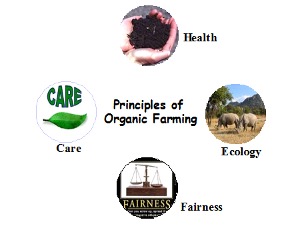
1. Principle of Health
👉🏻 Organic Agriculture should sustain and enhance the health of soil, plant, animal, human and planet as one and indivisible.
2. Principle of Ecology
👉🏻 Organic Agriculture should be based on living ecological systems and cycles, work with them, emulate them and help sustain them.
3. Principle of Fairness
👉🏻 Organic Agriculture should build on relationships that ensure fairness with regard to the common environment and life opportunities. Fairness is characterized by equity, respect, justice and stewardship of the shared world, both among people and in their relations to other living beings.
4. Principle of Care
👉🏻 Organic Agriculture should be managed in a precautionary and responsible manner to protect the health and well-being of current and future generations and the environment.
Area
- The total area under organic certification was
72.3 million hectaresduring 2019. This includes 26% cultivable area with 1.49 million ha and rest 74% forest and wild area for collection of minor forest produces. - Among all the states,
Madhya Pradeshhas coveredlargest areaunder organic certification followed byRajasthan,MaharashtraandUttar Pradesh. - During 2016,
Sikkimhas achieved a remarkable distinction of converting its entire cultivable land (more than 76,000 ha) under organic certification. Sikkim is thefirst fully Organic state. NABARD 2021 First Union Territories (UT)becomes fully organic isLakshadweep.Uttarakhandhas now become the first state in India to introduce anOrganic Agriculture Act. Through the Organic Agriculture Act, the government has taken official steps toward turning the state fully organic.- Most of the area in NE-Zone is being practiced with organic farming. The states like Tamil Nadu, Kerala, Madhya Pradesh, Himachal Pradesh and Gujarat are promoting organic farming vigorously.
- India is home to
30 per centof the total organic producers in the world, but accounts for just2.59 per cent(1.5 million hectares) of the total organic cultivation area of 57.8 million hectares, according to the World of Organic Agriculture2018report. Indiaranks first innumber of organic farmersandninthin terms of area under organic farming. (PIB 2020 - MoAFW)Australiais first rank in area under organic cultivation (12.2 Mha).
Relevance of organic farming
Interest in organic agricultural methods is growing, especially in areas where the present modern farming system has unleashed many agro-ecological and environmental problems both on and off the farm, which threaten food security. The following are some examples:
- Degradation of soil quality (structured & fertility)
- Pollution of soil, water and food with pesticides and nitrates
- Health effects on farmers, farm workers, farm families, rural communities (apart from concerns about the non-intended effects of pesticides on human beings in general, sound use of pesticides requires a technical knowledge which is often lacking in developing countries)
- Resistance of pests to pesticides
- Dependence on off-farm agricultural inputs which can increase poor farmers’ dependence on credit facilities (to purchase synthetic fertilizers, pesticides and seed), which may result in decreased local food security and self-reliance.
Further consumer awareness of the environmental costs of agriculture is increasing. The awareness of environmental quality and health is often promoted by environmental groups, especially in developed countries. The resulting demand for organic products creates the opportunity to sell organic products at premium prices, enabling organic farmers to continue, and often expand. Some governments have begun to recognize the possibility that it may be cheaper to support organic agriculture than to rectify problems associated with certain resource-destruction production practices.
For this reason, several governments have introduced subsidies for organic agriculture. For example, in Indonesia where, after a period of subsidies on pesticides, the use of this input was prohibited while efforts were put in IPM programmes. In China, pesticide problems in products both on the domestic and export market has resulted in government involvement in certification organizations for “green food”, including also a small amount of organic produce. Both these policies facilitate a shift towards organic agriculture.
Relative Characteristics of Modern and Organic Farming Systems
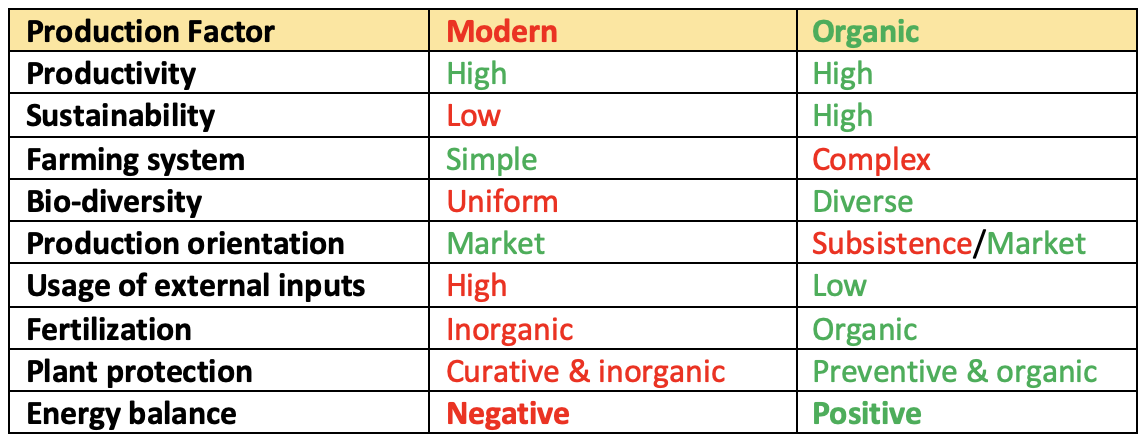
Components of Organic Farming
Thus, organic agriculture is comparatively free from the complex problems identified with modern agriculture. It is basically a farming system, devoid of chemical inputs, in which the biological potential of the soil and the underground water resources are conserved and protected from the natural and human induced degradation or depletion by adopting suitable cropping models including agro-forestry and methods of organic replenishment, besides natural and biological means of pest and disease management, by which both the soil life and beneficial interactions are also stimulated and sustained so that the system achieves self-regulation and stability as well as capacity to produce agricultural outputs at levels which are profitable, enduring over time and consistent with the carrying capacity of the managed agro-ecosystem. Crop production and health in organic farming systems is attained through a combination of structural factors and tactical management components to ensure products of sufficient quality and quantity for human and livestock consumption.
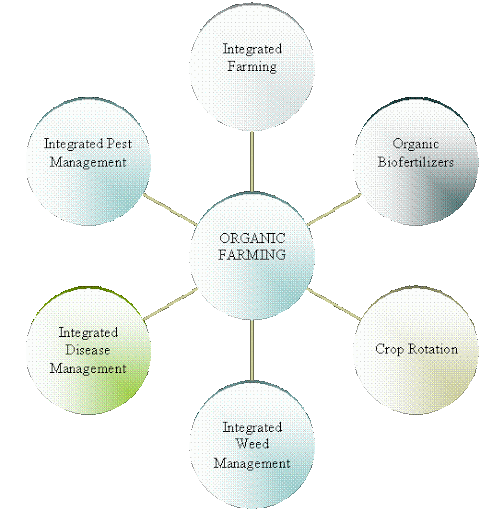
Diverse Crop Rotations
Crop diversification can deliver many agronomic and ecological benefits simultaneously, while maintaining or enhancing the scale and efficiency of production. Benefits of diverse crop rotations include yield stability, reduction in disease incidence & severity, reduced pest incidence, improved weed control, reduced soil erosion, recycling of nutrient reserves, transfer or nitrogen from nitrogen fixing species, structural improvement etc. There are many different forms of crop diversification viz., rotational cropping, sequential cropping, intercropping, multistoried cropping system etc., and in practice these can be combined within the farming system. Crop and variety choice and their spatial and temporal design are critical in ensuring an effective rotation. The inclusion of crops, which are able to fix atmospheric through symbiotic relationship with N-fixing bacteria that nodulate on crop roots, enables organic farming systems to be self-sufficient in nitrogen.
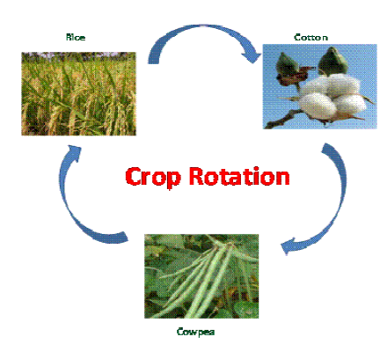
Soil Fertility Management
The aim of nutrient or soil fertility management within organic farming systems is to work, as far as possible, with in a closed system. Organic farming aims to manage soil fertility through use of organic manures (FYM & Farm compost, Vermicompost), recycling of crop residues such as straw, plant residues, grasses etc., dung and urine from domesticated animals and wastes from slaughterhouses, human excreta & sewage, biomass of weeds, organic wastes from fruit and vegetable production & processing units and household wastes, sugarcane trash, oil cakes, press mud and fly ash from thermal power plant. Biological nitrogen fixation through blue green algae, azolla for rice, rhizobium for legumes, azatobactor & azospirillum for other crops, green manuring & green-leaf manuring, manure from biogas plants, legumes in crop rotations & intercropping systems.
Weed Control
Organic farmers often identify weeds as their key problem. Within organic systems an integrated approach to weed control using a combination of cultural and direct techniques is necessary. Appropriate soil cultivation viz., deep ploughing in summer, harrowing, inter-cultivation using mechanical hoes and harrows, and the timing of field operations and good crop establishment are vital for successful control of weeds. Mulching the soil surface can physically suppress weed seedling emergence. Soil solarization, to heat field soil under plastic sheeting to temperatures high enough to kill weed seeds (>65°C) can also be used for weed, control in some parts of India. Good seedbed preparation, timely sowing, line sowing, crop rotation, smoother crops & intercropping systems etc., suppress the weed growth and favour normal growth and development of crops in organic systems.
Natural Pest and Disease Control
One of the important features of organic farming is the exclusion of plant protection chemicals for pest and disease control. The system relies on the on-farm diversity, improved health of the soil and crops, protective influence of beneficial soil organisms against soil borne pathogens and use of plant-based insecticides and biological control measures. The population of naturally occurring beneficial insects and other organisms which act as bio control agents multiplies making natural control of pests possible when the system is free from the indiscriminate use of chemicals.
Few examples are:
- Manipulation of crop rotations, to minimize survival of crop-specific pests (in the form of, for example insect eggs, fungi) which can infest the next crop.
- Strip cropping, to moderate spreading of pests over large areas.
- Manipulation of the moisture level or pH level of the soil (in irrigated areas)
- Manipulation of planting dates, to plant at a time most optimal for the crop, or least beneficial for the pest.
- Adjustment of seeding rate, to achieve an optimal density given the need to check weeds or avoid insects.
- Use of appropriate plant varieties for local conditions
- Biological control methods, to encourage natural enemies of pests by providing habitat or by breeding and releasing them in areas where they are required.
• Bacillus thuringensis against caterpillars of Heliothis, Earias, Spodoptera etc.
• Pseudomonas fluoroscenes against Pythium spp., Rhizoctonia spp., Fusarium spp.
• Nematodes like Green commandoes and Soil commandoes against caterpillars & grubs.
• Nuclear Polyhedrosis virus (NPV) against caterpillars
• Trichoderma virdi against many common diseases of vegetables and spices
• Weevils Neochitina eichorniae & N. bruchi against water hyacinth • Beetle Zygogramma biocolorata against parthenium - Trapping insects, possibly with the use of lures such as pheromones
- Use of domesticated birds
- Biological pesticides (for example neem oil, nicotine) of which the active ingredient is short-lasting, and which may be produced locally
Integrated Nutrient Management
Integrated nutrient management system envisages conjunctive use of organic manures, crop residues, bio-fertilizers, legumes in crop rotation and green manuring. It combines traditional and improved technologies to gain from the symbiosis and synergy of crop-soil-environment bio-interactions. The concept is for optimization of all available sources of plant nutrients to improve soil fertility availing nature’s gifts. Development of INM system involving and appropriate mix of organics, biological N fixation, phosphate solubilising microbes, and need based chemical fertilizers would be crucial for sustainability of production and soil as a resource base for it.
Bulky Organic Manures
In India, the estimate production of rural compost is about 226 million tons and urban compost of 6.6 million tons annually. Aggregate stability, decrease in pH, resistance to compaction, infiltration and water holding capacity. Proper methods of preparation of FYM/Compost therefore have to be popularized.
Recycling of Organic Wastes
Substantial quantities of crop residues (350 million tons) are produced in India every year. Crop residues in combination with organics have been shown to improve availability of plant nutrients, soil organic matter, aggregate stability, infiltration rate, microbial population etc.
Bio-Fertilizers
Bio-fertilizers such as rhizobium culture is an effective source of N supply to leguminous corps. Azotobacter and Azospirillium help in N fixation and supply to crops like rice, wheat, sorghum, maize, cotton, sugarcane, fruit corps and vegetables. Phosphate solubilising bacteria viz., Bacillus aspergillus help in making available soil P to the crops and increase the solubility of indigenous sources of P like rock phosphate. Blue green algae and Azolla have shown promise in low land rice. These are renewable and environment friendly supplementary sources of nutrients and are presently being used in quantities between 8-10 tons per year. Vesicular arbuscular mycorrhiza (VAM) has beneficial effect on plant growth, particularly in P deficient soils. Improved uptake of water, production of plant hormones and microbial activity are the prime benefits of mycorrhizal inoculations.
Green Manuring
Green manuring is a cheap alternative to the use of fertilizer N. The process also makes a positive contribution to the maintenance of soil organic matter at a satisfactory level. The stem nodulating green manure plant, Sesbania rostrata (Danchia) can fix 100-250 kg/N/ha in 45 to 55 days and has great scope in rice culture. There is also greater scope for green-leaf manuring for rice and other crops from the lopping of various multipurpose trees popularized through afforestation and agro-forestry systems. Popularization of bio-gas plants, encouraging legumes in crop rotation and intercropping system and use of sewage, sludges and effluents for agriculture can also be the components of INMS.
✅ Advantages of Organic Farming
- Nutrition - Improved soil health makes food dramatically superior in mineral content
- Poison-free
- Free of contamination with health harming chemicals like pesticides, fungicides and herbicides.
- Food tastes better
- Food keeps longer - can be stored longer
- Disease and pest resistance - because of healthy plants
- Weed competitiveness - Healthier crops able to compete
- Lower input costs - No costly chemicals used, nutrients are created in-situ (in the farm)
- Drought resistance
- More profitable - Due to greater food value of organic produce consumers are willing to pay premium prices
❌ Disadvantages of Organic Farming
- Productivity - Low productivity is often reported as the quantum nutrient used comparatively lower
- Labour intensive - Cultivation requires more labour especially for weed control
- Skill - requires considerable skill to farm organically Ex. Choice of alternatives for control of pests
- Lack of convenience in management compared to easier management like fertilizer application in conventional methods
👨👩👧 Synonyms of Organic Farming
- Eco-farming
- Biological farming
- Bio-dynamic farming
- Macrobiotic agriculture
Organic Certification
Organic certification it is a certification process for producers of organic food and other organic agricultural products. In general, any business directly involved in food production can be certified, including seed suppliers, farmers, food processors, retailers and restaurants. Requirements vary from country to country, and generally involve a set of production standards for growing, storage, processing, packaging and shipping that include:
- avoidance of synthetic chemical inputs (e.g. fertilizer, pesticides, antibiotics, food additives, etc) and genetically modified organisms (GMO);
- use of farmland that has been free from chemicals for a number of years (often, three or more);
- keeping detailed written production and sales records (audit trail);
- maintaining strict physical separation of organic products from non-certified products;
- Undergoing periodic on-site inspections.
A trademark - India Organic will be granted on the basis of compliance with the National Standards for Organic Production (NSOP). Communicating the genuineness as well as the origin of the product, this trademark will be owned by the Government of India.
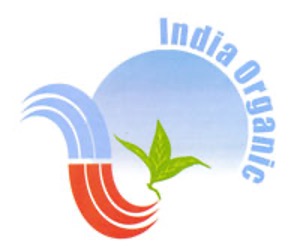
The National Standards for Organic Products was established in 2000 which ensures the authenticity of the organic product. The certification is issued by testing centers accredited by the Agricultural and Processed Food Products Export Development Authority (APEDA), NABARD 2021 under the National Program for Organic Production of the Government of India. In spite of the formation of the certification board in 2000, the scheme came into existence in the year 2002 which provides this mark to the real organics.
🤔 Can GMO products get this certification? No, it’s totally prohibited. It means an organic farmer can’t grow GMO crops and products. The GMO seeds can’t be used. Like for example if a cow is organic it can’t eat GMO feed and any organic product should not include GMO products as their ingredients
Inspection
- On-site visit to verify that the performance of an operation is in accordance with specific standards
- Evaluation and verification of agricultural production, processing and trading
- Inspection requires complete documentation by producers, processors and handlers. Findings are presented in a report to the certifiers.
Certification
- Monitoring the market for misuse of certification mark or label
- Assesses the results of the inspection in relation to the requirements of the organic standards
- Decides about issuing of certificates, conditions and sanctions
- Written confirmation that a process or product is in compliance with certain standards
- Certificate is granted
Labelling
- Easy recognition of organic quality and certification system
- Confirms the fulfilment of the label regulations and of legal rules
- They help to achieve a better price for organic products
NPOP is Internationally Recognized
- NPOP has equivalence agreement with European Union
- NPOP has equivalence agreement with Switzerland
- USDA has accepted NPOP conformity assessment system means product certified by any Indian certification body can be exported without the need for recertification in above countries. For USA Indian certification bodies issue certificate based on NPOP standards
Inspection and Certification Process
- Appointment of Inspection and Certification bodies
- Accreditation of Inspection and certification agency by NAB (National Accreditation Board).
- Deployment of competent persons for audit
- Undertaking inspection and certification
- Annual Surveillance and Review of Inspection and Certification Agencies
- Continuous improvement in system
- Renewal of accreditation at
3-year interval. - In Organic farming it is mandated not to use chemical inputs such as fertilizers, pesticides
before 2-3 yearsof marketing final product. NABARD 2019
Grower Group Certification
- Based on internal quality system
- Applicable to producer groups, farmer’s cooperatives, contract production and small-scale processing units.
- The producers in the group must apply similar production systems and the farms should be in geographical proximity.
- 25 to maximum 500 members.
Sustainable Agriculture
- Sustainable agriculture can be defined as the form of agriculture aimed at meeting the food and fuel needs of the present generation without endangering the resource base for the future generations.
- It includes study of Impact of Improved Crop Production Technology, Factors Affecting Ecological Balance, Evaluation of Sustainable Agriculture, Components of Sustainable Agriculture, Sustainable Utilization of Land Resources, Sustainable Utilization of Water Resources, Sustainable Utilization of Biodiversity, Integrated Nutrient Management, Integrated Plant Protection, Enhancing Sustainability of Dryland Agriculture, Enhancing Sustainability of Irrigated Agriculture, Agricultural Sustainability and Farming Systems.
- Sustainable agriculture is the practice of farming using principles of ecology, the study of relationships between organisms and their environment.
- It has been defined as “an integrated system of plant and animal production practices having a site-specific application that will last over the long term”:
- Satisfy human food and fiber needs
- Make the most efficient use of non-renewable resources and on-farm resources and integrate, where appropriate, natural biological cycles and controls.
- Sustain the economic viability of farm operations
- Enhance the quality of life for farmers and society as a whole.
Objectives of Sustainable Agriculture
- Make best use of the resources available.
- Minimize use of non-renewable resources.
- Protect the health and safety of farm workers, local communities and society.
- Protect and enhance the environment and natural resources.
- Protect the economic viability of farming operations.
- Provide sufficient financial reward to the farmer to enable continued production and contribute to the well-being of the community.
- Produce sufficient high-quality and safe food.
- Build on available technology, knowledge and skills in ways that suit local conditions and capacity.
LEISA
Low-External-Input Sustainable Agriculture (LEISA)is agriculture which makes optimaluse of locally available natural and human resources(such as soil, water, vegetation, local plants and animals, and human labour, knowledge and skill) and which is economically feasible, ecologically sound, culturally adapted and socially just.
🌬 Paramparagat Krishi Vikas Yojana (PKVY)
- It is an initiative to promote commercial organic production through certified organic farming in the country. This scheme was launched by Government of India in
2015. - Under PKVY organic farming is promoted through cluster adoption of organic village by
cluster approachand PGS certification. • Under PKVY scheme, an area of 5 lakh acre is targeted to be covered through 10,000 clusters of 50 acres each form the year 2015-16 to 2017-18.
Zero budget natural farming (ZBNF)
-
Zero budget natural farming (ZBNF) is a method of chemical-free agriculture drawing from traditional Indian practices.
-
It was originally promoted by Maharashtrian agriculturist and Padma Shri recipient
Subhash Palekar, who developed it in the mid-1990s as an alternative to the Green Revolution’s methods driven by chemical fertilizers and pesticides and intensive irrigation. -
He argued that the rising cost of these external inputs was a leading cause of indebtedness and suicide among farmers, while the impact of chemicals on the environment and on long-term fertility was devastating. Without the need to spend money on these inputs — or take loans to buy them — the cost of production could be reduced and farming made into a “zero budget” exercise, breaking the debt cycle for many small farmers.
-
Instead of commercially produced chemical inputs, the ZBNF promotes the application of
jeevamrutha— a mixture of fresh desi cow dung and aged desi cow urine, jaggery, pulse flour, water and soil — on farmland. This is a fermented microbial culture that adds nutrients to the soil, and acts as a catalytic agent to promote the activity of microorganisms and earthworms in the soil. About 200 litres of jeevamrutha should be sprayed twice a month per acre of land; after three years, the system is supposed to become self-sustaining. Only one cow is needed for 30 acres of land, according to Mr. Palekar, with the caveat that it must be a local Indian breed — not an imported Jersey or Holstein. -
A similar mixture, called
bijamrita, is used to treat seeds, while concoctions using neem leaves and pulp, tobacco and green chillis are prepared for insect and pest management. The ZBNF method also promotes soil aeration, minimal watering, intercropping, bunds and topsoil mulching and discourages intensive irrigation and deep ploughing. Mr. Palekar isagainst vermicomposting, which is the mainstay of typical organic farming, as it introduces the most common composting worm, the European red wiggler (Eisenia fetida) to Indian soils. He claims these worms absorb toxic metals and poison groundwater and soil. Several States, including Andhra Pradesh and Himachal Pradesh, have been aggressively driving a shift towards this model.
Is it effective?
ZBNF critics, including some experts within the Central policy and planning think tank NITI Aayog, note that India needed the Green Revolution in order to become self-sufficient and ensure food security. They warn against a wholesale move away from that model without sufficient proof that yields will not be affected. Sikkim, which has seen some decline in yields following a conversion to organic farming, is used as a cautionary tale regarding the pitfalls of abandoning chemical fertilizers. NITI Aayog has been among the foremost promoters of Mr. Palekar and the ZBNF method. However, its experts have also warned that multi-location studies are needed to scientifically validate the long-term impact and viability of the model before it can be scaled up and promoted country-wide.
Explore More 🔭
🟢 https://www.youtube.com/watch?v=xFqecEtdGZ0 https://youtu.be/ee7muQ_qKU0
Precision Farming
- “Precision farming is a
site specific crop management approachin modern crop production for applying agro-chemicals to the field in an economical and environmentally sound fashion”. - Precision farming means high tech agriculture, spatial variability management. FCI AGM 2021
- It is the technique or method to find out the use of appropriate inputs, appropriate technology, decreasing cost of cultivation decisions, optimizing outputs for safety and security of food according to site or soil condition.
- Precision farming uses information-based farm management for optimum profitability, sustainability and resource utilization.
- The required information for Precision farming is obtained with the help of technologies like
Geographic Information System (GIS),Global Positioning System …
Become Successful With AgriDots
Learn the essential skills for getting a seat in the Exam with
🦄 You are a pro member!
Only use this page if purchasing a gift or enterprise account
Plan
- Unlimited access to PRO courses
- Quizzes with hand-picked meme prizes
- Invite to private Discord chat
- Free Sticker emailed
Lifetime
- All PRO-tier benefits
- Single payment, lifetime access
- 4,200 bonus xp points
- Next Level
T-shirt shipped worldwide

Yo! You just found a 20% discount using 👉 EASTEREGG

High-quality fitted cotton shirt produced by Next Level Apparel